Habeni Primary
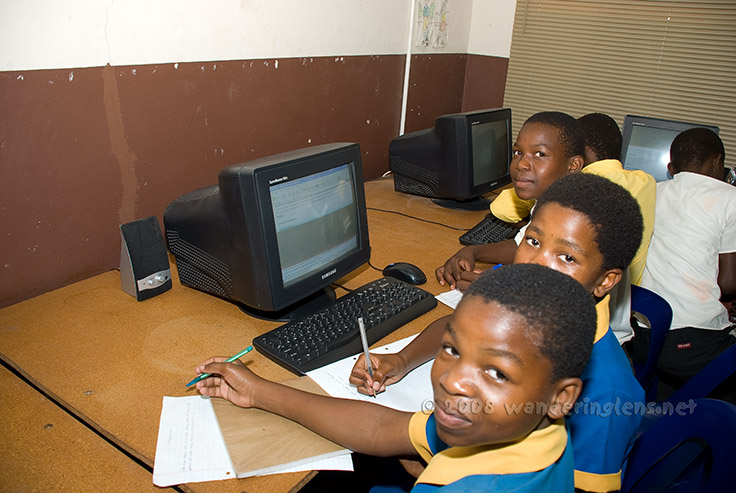
Classroom scene
Habeni Primary school is in Zululand, and has recently acquired a computer lab. Courtesy of Kelsey Wood and Wizzy Digital Courier, it also has Internet.
Education
In Africa, children walk to school. In South Africa, where I am based, schools and clinics are the only large buildings in the rural areas, and are thus easily spotted with their long roofs. The minimum requirement for a school are rooms, teachers, blackboards, and students. I have come across many schools that have no more than those basics.
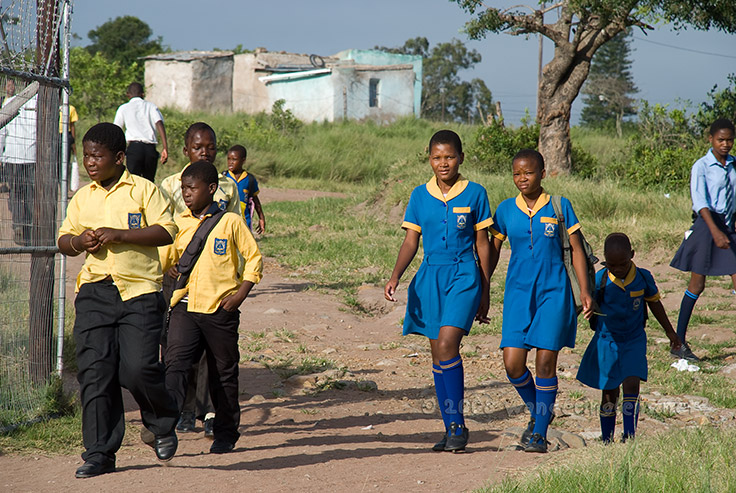
Walking to school
Buildings and a roof also mean that a gutter and large plastic tank is setup to catch water, for drinking. The next priority service to arrive is either electricity, or a telephone. Some schools have one and not the other. Electricity is for lights, charging cellphones, and boiling water. Cellphones are everywhere - even very far out in Zululand.
Electricity and computers
If Eskom, South Africa’s electricity provider, gets to the school, the possibility arises of using computers.
The first computer is invariably placed in the Principal’s office, or very close by. It is used to track the children, and make sure their parents have paid for their schooling. Next, it is used to prepare documents, and write letters.
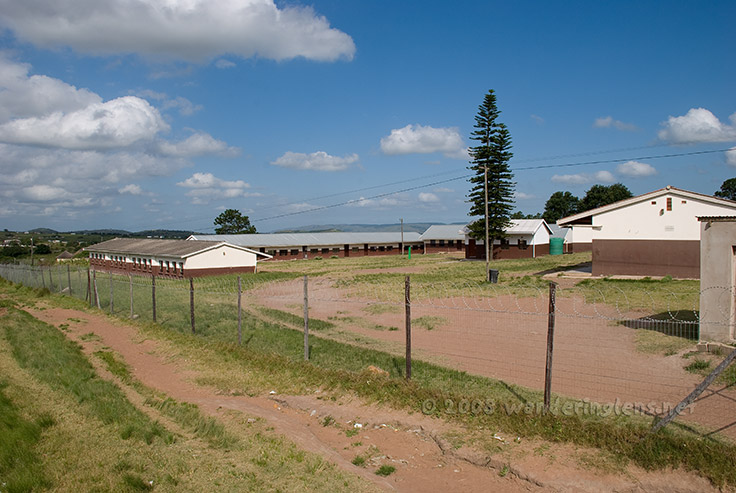
Habeni school
Maybe someone like the Shuttleworth Foundation or a local company has provided more computers, for the children to use. the Shuttleworth Foundation has funded well over one hundred such schools, and I have been involved in many of their installations. Sometimes the schools themselves have found funding, and I have installed computers at those schools as well.
We all know that computers are important - but what can the children learn about computers in such an environment ? I have seen many such installations, and can report that children are excited and happy to use computers. First thing they find are the games, and from those they quickly learn how to use a mouse, and, with certain games, mastery of the keyboard.
The Champion
From here, is is an uphill trudge again - and it is critically dependent on a good teacher to guide them. In fact, let us take a step back and decide the prerequisites for putting a computer lab into a school in the first place. For me, they come down to :-
- Electricity
- Computers
- A secure lab environment
- A Champion - someone at the school who is willing to make it a success
Without all of these, there is no point in going ahead. In particular, if there is no champion, the project will never bear fruit. I have failures that attest to that. Teachers can find computers intimidating, and the more so because the children do not. I explain from the outset that the children have more time, and inclination, to learn, and will quickly become more familiar than the teachers. If my designated champion cannot get over that - well - I have saved myself a lot of time.
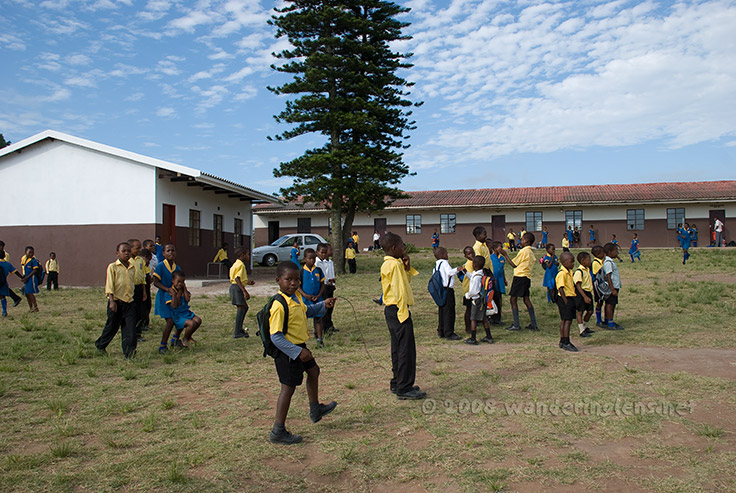
Habeni school
Internet
So - what will the children learn about computers during their time at school ? We can think of a lot of things, but one that is almost dismissed out of hand is Internet. But - lets face it - that is why you buy a computer, and why your mother buys a computer. If the kids come out of school with no appreciation of Internet, I think the school has failed them.
What does it take to get that appreciation ? What can be installed on those computers to help them over the hurdle ?
Wikipedia
I have found the Killer App - the thing that is cheap, easy to use, and gives that sense of awe that we all got on our first encounter with Internet. It is Wikipedia. I used to put the whole copy on the English wikipedia down, duplicating the server setup at wikimedia foundation, using apache, mediawiki, and mysql. However, the picture archive and server requirements have now completely outstripped what I can provide, so I settle for one of a number of article collections that have been assembled for precisely my school audience. I use the SOS Children release, which has articles on about 4,500 topics. A drop in the ocean compared to the real thing, but with good coverage of articles for schools, and a glance over for proofreading.
This gives them something to read - introduces the HTML metaphor, links, and self-paced instruction that we all love about the web.
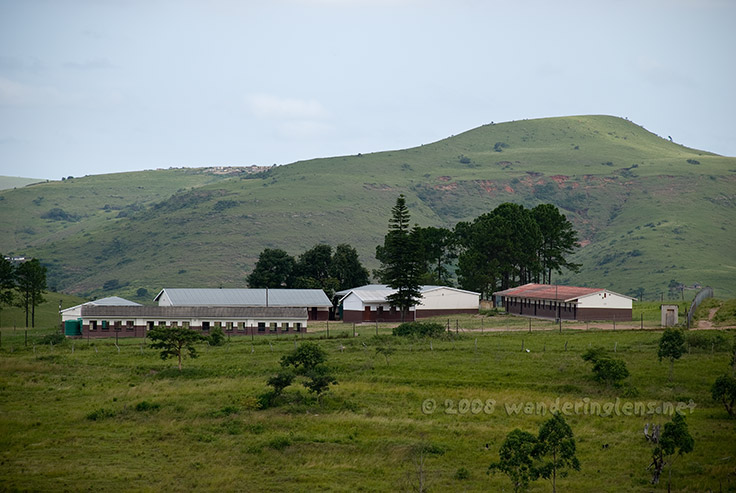
Habeni primary school
But .. Internet is nothing without Email. Web is broadcast like TV - Emailis one-to-one like the phone.
Wikipedia comes with the initial install - a one-time dump of information. Email requires connectivity. We (in the first world) use broadband, wireless, telephone lines, money. What options does a rural school in Zululand have ?
You can read about all Wizzy Digital Courier’s offerings, but I will cut to the chase and talk about our rock-bottom offering for schools with not even a telephone line. Mervyn, the Champion at the school, lives in Eshowe and drives to the school every day. He stops in to Eshowe High School, which has a Wizzy Digital computer connected to their always-on ADSL line. Email for Habeni Primary arrives at this computer, and waits for Mervyn, who plugs in a USB stick, logs in to a web interface, and transfers all the school’s email to the stick with one click.
He logs out, unplugs the stick, and drives to the school. A similar interface at the school computer transfers all inbound mail to the school computer, and any mail waiting to leave on to the stick. When Mervyn next visits Eshowe High, that mail will be sent to its destination.
Here, a USB stick travelling regularly back and forth along a fixed route has substituted for a telephone line. It has high capacity, and has no direct costs. Obviously Eshowe High has some costs associated with this, but they are willing to provide this service.
Web
Mervyn has another trick up his sleeve. A management interface at the school allows him to select some websites, and pick certain pages to be scooped, either once-off, or on a regular basis (useful for news sites). These scoop requests travel along with the email, and Eshowe High will fetch these pages, and package them up for delivery back to Habeni.
Linux
Though the software is built on top of Linux, the computer lab can be either Windows (supplied free to South African schools) or Linux. I recommend a Thin Client system, built around Edubuntu.
Photos credit Kelsey Wood, Wandering Lens Photography - and check these and other galleries at wanderinglens.net